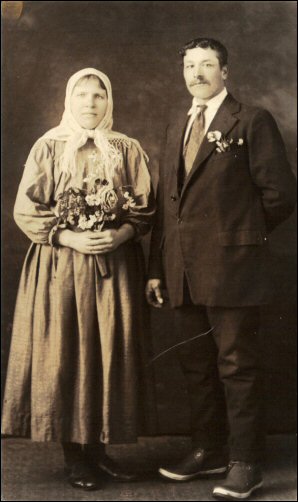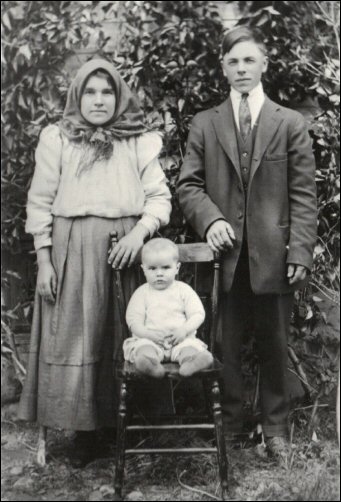by Margaret Salekin
In 1915-1917, the Christian Community of Universal Brotherhood (CCUB) purchased 13,500 acres of land in the Lundbreck and Cowley areas of Alberta. There, in the foothills of the Rockies, they planted extensive grain fields, raised large livestock herds and established thirteen communal villages as well as a flourmill, two elevators, central storehouse, prayer home, blacksmith shops, granaries and barns. Following the demise of the CCUB in 1937-1938, the lands were sold and the villages were dismantled. A number of Doukhobor families, however, chose to remain in the area as farmers, where they continued to practice their faith and culture. The following article, reproduced by permission from ISKRA Nos. 2034-2036 (Brilliant: USCC, 2010), examines the history of Doukhobor settlement and life in the area, through the experiences of the Konkin family.
On March 11th, 2010, the Doukhobor Prayer Home in Lundbreck, AB was designated as a Provincial Historic Resource. Today, the Prayer Home stands as a reminder of a once thriving Doukhobor community that worked and developed the land in the Lundbreck-Cowley area of south western Alberta.
How did this community come into existence? Let us follow the development through the experiences of the Harry Konkin family.

Harry and Nastia Konkin with their four daughters near Lundbreck, AB c. 1915.
Some years after the migration of the Doukhobors from Saskatchewan to British Columbia, it was realized that land needed to be bought for grain growing and raising horses. The grain was needed for milling and for feed. The horses were needed for the community in BC where they were used for logging, etc. Land was chosen in the Cowley and Lundbreck area of Alberta. In 1915, fourteen workers and their families made the move from BC. Some of the first settlers were Samuel Verigin, Vanya Ewashen, Misha Maloff, Fedya Sookochoff, Vasya Zibin and their families. The first land that was purchased was nine miles north of Lundbreck and it was given the name Bogatoi Rodnik. This is where the Harry Konkin family eventually settled. In 1916, more men were added to the workforce: Vanya Ribalkin, George Maloff and sons, George and Samuel Kalmakoff, Michael Salekin and family, Cecil N. Maloff and others. Peter Lordly Verigin also approached Harry Konkin, who was a horse trainer and asked him to gather his family and other dependable people who were capable of working with horses to relocate to south western Alberta. Steam engines, grain separators (threshing machines) and ploughs were purchased. Oxen, cows and horses were acquired.

CCUB steam engines – “Doukhobor Plow Horses” – at Cowley, AB, c. 1925.
Approximately, 10,000 acres were bought in Lundbreck and Cowley. Another 2,000 acres were purchased a couple of years later. Thirteen villages were established: four in Lundbreck, five in Cowley and four others in the vicinity. Some of the villages and names of some of the people who lived there were:
- Bogatoi Rodnik – Verigin, Ewashen, Maloff, Sookochoff, Zibin
- Lundbreck – Hoobanoff, Konkin
- Stoopnikoff Village – Stoopnikoff, Parakin
- Ribalkin Village – Ribalkin, Faminoff, Maloff, Ozeroff
- Faminoff Village – Paul Faminoff with his three sons, Fred, Joe and Sam
- Gradovaya Dolina – Kabatoff, Kooznetsoff, Verigin
- Sibir – Vishloff, Konkin, Shkuratoff, Sookochoff
- Cowley – Vishloff, Hoobanoff, Kalmakoff, Konkin, Potapoff
- Bozhiya Milost – Verigin, Negraeff
- Maloff Village – Maloff, Sookochoff
- Village east of Cowley – Maloff, Babakaeff, Vishloff
- Bozhiya Celo – Ewashen, Bojey, Kooznetsoff, Barisenkoff, Stoopnikoff, Larin, Shkuratoff
The community also built a flour mill in Lundbreck and grain elevators in both Cowley and Lundbreck. A house was built for Peter Lordly Verigin in Cowley that he used when he visited the community and checked on the farming operation. This building was also used as the headquarters for the community. A Community home was also located on the same street. The community which grew to 360 people prospered until the break-up of the CCUB in 1938. The community hall was then dismantled.

CCUB flour mill at Lundbreck, AB. Relocated there from Pincher Creek in 1922, it was operated until its destruction in 1936.
In the late 1930’s, some families left the CCUB and began to work for themselves. Some found employment with the CPR while others rented land that they farmed. After the demise of the CCUB in 1938, the number of Doukhobors in the Lundbreck-Cowley area decreased by a third. Most of these people moved to British Columbia to be part of the larger group living there.
The National Trust Co. made the Alberta members responsible for over $91,000 of the CCUB debt. Assessments were made of the various lands to total the indebtedness. In many cases the member took possession of the land that he was already residing on, making payments and eventually obtaining a clear title as a private owner. Payment for the land was made on a one-third crop share basis as the members did not have cash. They were given ten years to clear the debt, which they all did.

Doukhobor village of Bogatoy Rodnik north of Lundbreck, AB which two son-in-laws of the Konkin’s – Peter M. Salekin and Anton W. Mushta – purchased in 1938.
By this time, all of Harry and Nastia Konkin’s daughters had married. Their youngest child, a son Harry, passed away at the young age of twenty-four. Two brothers-in-law, Peter M. Salekin and Anton W. Mushta, husbands of Helen and Emma, bought Bogatoi Rodnik, the farm where they had been living. Their mother-in-law Nastia, who was now a widow, lived there with them. The oldest daughter Mary and her husband Alex F. Vishloff bought communal land near Cowley and their youngest daughter Ann and her husband Mike S. Verigin bought communal land further east. Their other daughter Nastia and her husband Nick A. Shkuratoff bought communal land west of Bogatoi Rodnik. The Shkuratoff family later relocated to the Slocan Valley of BC.
Along with the farming, the two brothers-in-law, Peter and Anton went to work in the coal mines of the Crowsnest Pass to help pay for the land. This additional income allowed them to occasionally buy such luxury items as corn flakes and peanut butter for their families. Large fields of potatoes were also planted. After the harvest, sacks of potatoes were sold door to door on weekends, in the mining communities of the Crowsnest Pass.


Alex F. and Mary H. (nee Konkin) Vishloff, Lundbreck, AB. Nastia H. (nee Konkin) and Nick A. Shkuratoff, Lundbreck, AB.
When the sons in the two families were old enough to work with their fathers, it became evident that more land was needed to sustain the two families. The Mushta family sold their share to the Salekin family and bought a farm east of Lundbreck. For a number of years, they retained some land for pasture at Bogatoi Rodnik.
The people in the Lundbreck and Cowley areas continued to uphold their Doukhobor religion and culture. A Russian school existed for a couple of years. An organization for the youth was established. Petrov Dyen was commemorated annually with picnics at Bogatoi Rodnik, near the Castle River at Bozhaya Dolina or on the South Fork River between Pincher Creek and Cowley.


Helen H. (nee Konkin) and Peter M. Salekin, Lundbreck, AB. Emma H. (nee Konkin) and Anton W. Mushta and son Peter.
Sobraniye were held in individual homes. Visiting choirs from BC and other guests were always welcomed. Choir presentations were held in the local community hall. Rent had to be paid for the use of the community hall and private homes often became crowded and their location, at times, was inconvenient. It was decided that they needed to build a dom for their own use. Fundraisers were held. The women held raffles where prizes included a homemade wool blanket and rugs that were made on the loom. Suppers, such as vereniki feeds, were held. All the ingredients for the suppers and the items for the raffles were donated. Construction commenced in 1953 with the men working as volunteers.
On August 22nd, 1955, a meeting, chaired by Peter C. Maloff, was held at the Peter M. Salekin farm at Bogatoi Rodnik. It was decided by all those present to register their organization as the United Doukhobors of Alberta Lundbreck-Cowley. The first chairman was Steve S. Faminow and the secretary-treasurer was William S. Kabatoff. The first trustees were Alex A. Vishloff,
Peter C. Maloff and Mike S. Faminow.

Ann H. (nee Konkin) and Mike S. Verigin, Lundbreck, AB.
Though it was not entirely completed, the dom was first used in 1955 for the funeral of Paul N. Potapoff, who served as the manager of the CCUB in that area.
Once again, in the 1950s and 1960s, the number of Doukhobors living in the Lundbreck-Cowley area continued to decline. The older generation was aging. In some families, sons or daughters were taking over the farming operations. Others began to leave the family farms to either further their education or to obtain employment in the cities.
This trend was evident in the Salekin family. Peter and Helen’s oldest sons, Mike and Harry continued to farm together with their parents. Additional land was acquired south of Lundbreck and Mike and his wife, Mary moved to this farm but they continued to farm as one unit. They began to do custom work to help pay for the land and the farm machinery. Eggs, cream and butter were also sold. Larry, the youngest son in the family, had always helped with the farm work but upon graduation from high school, he pursued post-secondary education and obtained a teaching degree in Lethbridge.

Aerial view of Bogatoy Rodnik taken in the early 1960’s.
Larry and I were married in 1970. We lived at the Bogatoye (as it was fondly referred to) for a few months after our marriage and I had the opportunity to learn some of its history from Larry’s parents. I enjoyed listening to my Mother-in-law’s stories of her experiences. She moved south of Lundbreck to live with her husband’s parents once she was married. The Salekin family lived there with the Parakin, Semenoff and other families. Their two oldest sons were born there. The young family then moved to Bogatoi Rodnik. By this time, another house had been built there by the Doukhobors. This house was referred to as the “blue” house while the original house was referred to as the “yellow” house as that was its colour at the time of purchase. Each of these houses was home to 50-55 people. Mother-in-law talked of taking her weekly turns at preparing meals for all who lived in the house, milking cows, working in the large gardens, etc. She also explained how an area of the house, bedroom, referred to as the hornitsa, that consisted of a sitting room and a bedroom, was used only by Peter Lordly Verigin and later by Peter P Verigin (Chistiakov) during their visits to the area. In the 1950s when John J and Laura P Verigin toured the area with a choir, the Salekin family was pleased to welcome them into their home to see where the elder Verigins had stayed.
In 1971, Peter and Helen sold the farm to Mike and Harry. They moved to Grand Forks, BC to spend their retirement years living near their daughter, Vera and her husband, Pat Semenoff. They joined the USCC organization. Good health allowed them to enjoy and participate in various events and functions. For a number of years, Helen was able to participate in the Ladies Organization (cooking groups).
The two brothers continued to farm for three more years. In 1974, after almost sixty years (1915-1974) of Doukhobor ownership, the farm was sold.

Cousins Nick N. Shkuratoff and Harry P. Salekin taken in front of the barn at Bogatoy Rodnik. Note the hand-carved shingles on the front of barn.
Today, the original house that had been bought with the land in 1915 and the large barn, with room for up to fifty horses, which had been built by the Doukhobors, are still in use and are still in good condition. There is an interesting fact to note. The house had been ordered from the Eaton’s catalogue in the late 1800s by the original owner of the land, a Mr Terril. Such houses are called Eaton’s houses. The second house was dismantled in the early 1940s. The last of the former CCUB land in the Lundbreck area was sold in the early 1990s by the sons of Jack and Mabel Semenoff. Mabel was a granddaughter to Harry and Nastia Konkin and the daughter of Anton and Emma Mushta. The flour mill once stood on the land that was sold by Vince. Terry sold his land which had once been part of the Faminoff village. A small amount former CCUB land in the Cowley area is stilled owned by Maloff descendants.
During its 50+ year history, the Dom was used for many occasions. Moleniye, sobraniye, funeral services and even a couple of wedding showers were held there. To this day, the Dom has never been used for a wedding. In 1994-1995, the Voices for Peace Choir held practices there. Meetings of the CCUB Trust Fund Board were held there when it was Alberta’s turn to host the delegates. Council of Doukhobors in Canada (Unity) meetings were held in Lundbreck because of its central location between BC and Saskatchewan. Guests were always welcomed and many meals were served. With the decline in the membership came the decline in the usage of the Dom. The commemoration of Petrov Dyen continues to be observed annually at the end of June. The Dom is available for use whenever it is required. Today out of a membership of about twenty-five, four members live in the area – Michael M Verigin of Cowley who served for many years as the secretary-treasurer of the United Doukhobors of Alberta, Mary Stoochnoff of Lundbreck, William G Maloff and Helen Juroloff of Hillcrest. They are grandchildren or great grandchildren of the original Doukhobors that came to the area.

The United Doukhobors of Alberta Prayer Home in Lundbreck, AB.
Many of the descendants of Harry and Nastia Konkin, who were life-long members and strong supporters of the CCUB, continue to be contributing and active members in the Doukhobor community. Many, living in Kelowna, Grand Forks, the Kootenays and here in Alberta, are members of the USCC, the organization that succeeded the CCUB.
A highway sign had been erected in 1974 just west of Cowley to give recognition to the contribution made by the Doukhobors to the area.
Now, with its Provincial Historic Resource designation, the Prayer Home in Lundbreck will continue to be a place of welcome and may its presence in the community continue to tell the story of the Doukhobors and their contributions in the Lundbreck-Cowley areas…
I extend my gratitude to Michael M Verigin and Peter A Mushta for providing and confirming some of the historic information. I trust that this article will provide a better understanding of this often forgotten and sometimes misunderstood, piece of Doukhobor history.
View Cowley-Lundbreck, Alberta Doukhobor Villages, 1915-1939 in a larger map.
